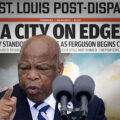
ABOVE PHOTO: The interior of the Ferguson Starbucks Cafe.

Linda Wallace
By Linda Wallace
Ferguson, Mo. — People around the globe know of Ferguson, Missouri and how it became famous virtually overnight.
Michael Brown, an 18-year-old unarmed African-American man died here at the hands of a White police officer. After it was announced that a grand jury would not indict the officer, tensions erupted into anger, casting a spotlight upon the state of police-community relations.
In the three years since Brown’s death, the residents and the businesses in Ferguson have been working to create a different narrative, one that centers on preparing underserved youth for employment opportunities, and fosters opportunities for business to rethink urban outreach and sales models.

Cordell Lewis, manager of Ferguson Starbucks.
The signs of progress are modern, sometimes shiny, and unmistakable. The Urban League of Metropolitan St. Louis and the Salvation Army have opened the $5.8 million Ferguson Community Empowerment Center, which will house Save Our Sons, an Urban League initiative that provides job training and employment opportunities to young at-risk men.
The center is symbolically located near the street where Brown died, at 9420 W. Florissant Ave. It rose from the ashes of the QuikTrip gas station, which burned down during the rioting that followed Brown’s death.
The $10.3 million Metro transit facility in Ferguson has opened with a redesigned service plan for the north county area, an employment boon for those residents who rely on public transportation, especially youth.
And then, there is Starbucks, which opened last year with a unique mission. This store is part of the chain’s national initiative to open stores in 15 diverse low- to medium-income communities across the United States. Starbucks visualizes the customer of the future living in areas that have been largely ignored or abandoned by other retailers.
According to the U.S. Census Bureau, the poverty rate in Ferguson is 22 percent; since the riots, economic growth has not yet climbed back to the 2014 level, even though 41 new companies moved into town. Ferguson is emerging as a microcosm of a trend reshaping the national landscape: the middle class is shrinking, while lower- income communities are gaining shares.
If a national chain such as Starbucks is to grow, then it has to figure out how to succeed in Ferguson and cities just like it.

Starbucks is promoting Natalie’s a Black-owned business and encouraging customers to eat there. Her caramel cake is a popular item, and sells out quickly.
“Nothing like this had been done before, so we would be pioneers in developing these programs,” said Cordell Lewis, who manages Ferguson’s Starbucks and has hired his entire staff from cities within a five-mile radius in and around the town. “I didn’t quite realize how much I would learn.”
The store has quickly become a model for similar Starbucks cafes in East Baltimore; Phoenix, the Jamaica neighborhood of Queens, New York; and Englewood in Chicago’s Southside. Others will open in Birmingham, Alabama and Long Beach, California.
“When we first opened, we didn’t know what to expect from a business standpoint,” said Lewis, whose store managed to turn a profit in its first year of operation. “We really got out in the community and introduced ourselves and invited the community to engage in the new space.”
Just how does the new model differ? The Ferguson Starbucks was built with a large community room, which any resident can reserve for free to hold meetings. A community bulletin board tells you what’s going on in town. This is a place where groups can work on the city’s challenges, or just hold a
dialog. Right after the opening, Lewis hosted a Conversation with Cops in his store. At least 15 Ferguson police officers came, along with Black Lives Matter activists, and Ferguson residents who wanted to support their local police. It was a hard conversation, he recalls.
 The store is hosting free tasting sessions on Saturday mornings to acquaint the locals with its coffee drinks, as some coffee novices were unfamiliar with the products.
The store is hosting free tasting sessions on Saturday mornings to acquaint the locals with its coffee drinks, as some coffee novices were unfamiliar with the products.
Moreover, to demonstrate its commitment to economic inclusion, Starbucks partnered with a minority-owned contracting firm on the construction of its building. It is purchasing baked goods locally from Natalie’s Cakes & More, a minority-owned business that suffered severe damage in the rioting. The new partnerships, coupled with construction costs, have contributed to over $10 million in indirect economic benefit over the last year, according to a Starbucks press release. Moreover, Natalie’s products are now served in over 30 Starbucks locations in Missouri and two in Illinois, and her workforce has grown to accommodate the demand for items like her signature caramel cake.
“A lot of our customers and a lot of Starbucks customers like to call us Natalie’s Starbucks,” said Natalie DuBose, who opened her business in June 2014 while she was still working nights as a hotel van driver. “Just being connected with Starbucks, in general, has made the growth of the company phenomenal, because whoever didn’t know Natalie’s, knew Starbucks.”
 The centerpiece, however, is the heavy focus on youth employment and job training. In the community room at Starbucks, the Urban League of Metropolitan St. Louis conducts job-skills training for young people. The multi-week program is based on Starbucks own customer service training and has graduated 65 young people since its launch, many of which have already found work locally.
The centerpiece, however, is the heavy focus on youth employment and job training. In the community room at Starbucks, the Urban League of Metropolitan St. Louis conducts job-skills training for young people. The multi-week program is based on Starbucks own customer service training and has graduated 65 young people since its launch, many of which have already found work locally.
“Hosting classes in the Starbucks training space gives me an opportunity to use real-life, spot-on experiences as I’m covering material,” said Monique Williams-Moore, a project director for the Urban League and facilitator of the classes. “The room we’re in, although closed in, is all windows, so I can point out something that’s going on at the cash register and ask questions or have conversations based on what’s going on in the store.”
For Lewis, the heart of the store is his 23 employees, known in store lingo as “Starbucks’ partners.” They must commit to participate in regular community service activities in the city, such as helping to maintain the Ferguson community garden. He meets with his staff to discuss the state of the city, as well as the state of the store. ln return, some baristas are getting their first job with full benefits – including health care coverage and free college tuition.
“We want to support people through challenging times and help them overcome them,” Lewis explained.
In other words, doing well by doing good.

















Leave a Comment